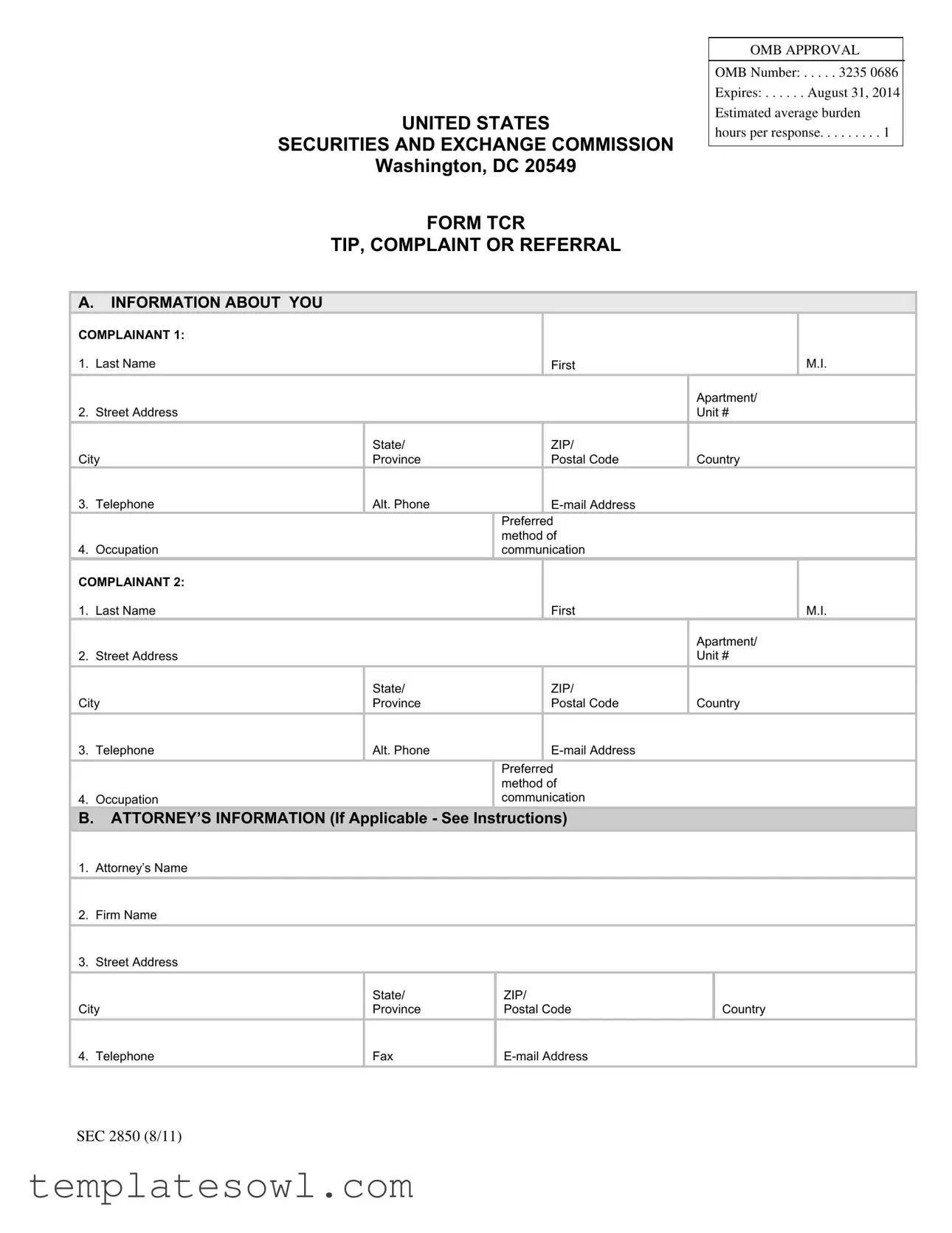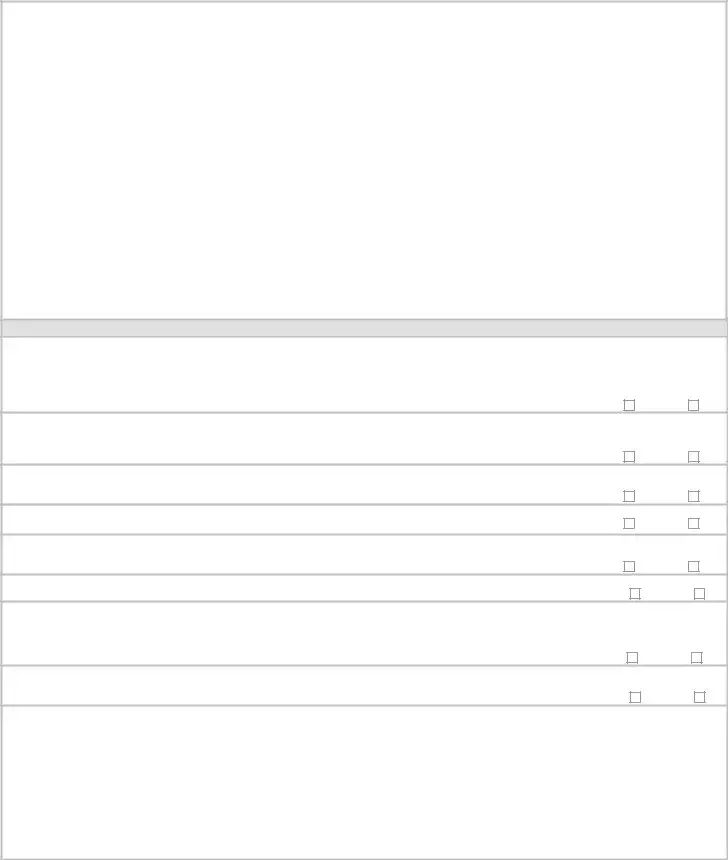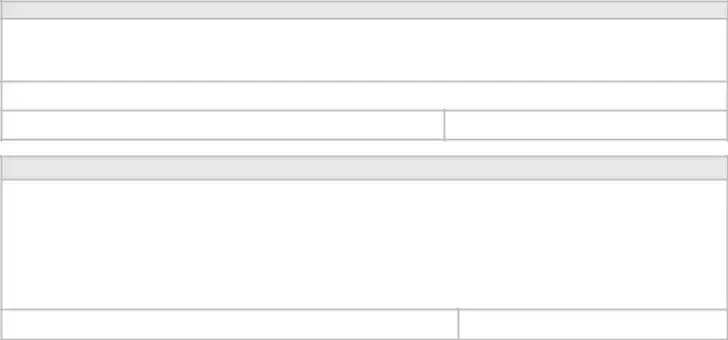UNITED STATES
SECURITIES AND EXCHANGE COMMISSION
Washington, DC 20549
FORM TCR
TIP, COMPLAINT OR REFERRAL
OMB APPROVAL
OMB Number: . . . . . 3235 0686
Expires: . . . . . . August 31, 2014 Estimated average burden hours per response. . . . . . . . . 1
A. |
INFORMATION ABOUT YOU |
|
|
|
|
|
|
COMPLAINANT 1: |
|
|
|
|
|
|
1. |
Last Name |
|
|
First |
|
|
M.I. |
|
|
|
|
|
Apartment/ |
2. |
Street Address |
|
|
|
Unit # |
|
|
|
|
|
|
|
|
|
|
State/ |
|
ZIP/ |
|
|
|
City |
Province |
|
Postal Code |
Country |
3. |
Telephone |
Alt. Phone |
|
E-mail Address |
|
|
|
|
|
|
Preferred |
|
|
|
|
|
|
method of |
|
|
|
4. |
Occupation |
|
communication |
|
|
|
COMPLAINANT 2: |
|
|
|
|
|
|
1. |
Last Name |
|
|
First |
|
|
M.I. |
|
|
|
|
|
Apartment/ |
2. |
Street Address |
|
|
|
Unit # |
|
|
|
|
|
|
|
|
|
|
State/ |
|
ZIP/ |
|
|
|
City |
Province |
|
Postal Code |
Country |
|
|
|
|
|
|
|
|
3. |
Telephone |
Alt. Phone |
|
E-mail Address |
|
|
|
|
|
|
|
|
|
|
|
|
|
|
Preferred |
|
|
|
|
|
|
method of |
|
|
|
4. |
Occupation |
|
communication |
|
|
|
B. ATTORNEY’S INFORMATION (If Applicable - See Instructions) |
|
|
|
1. |
Attorney’s Name |
|
|
|
|
|
|
|
|
|
|
|
|
|
|
2. |
Firm Name |
|
|
|
|
|
|
|
|
|
|
|
|
|
|
3. |
Street Address |
|
|
|
|
|
|
|
|
|
|
|
|
|
|
|
State/ |
ZIP/ |
|
|
|
City |
Province |
Postal Code |
|
Country |
|
|
|
|
|
|
|
4. |
Telephone |
Fax |
E-mail Address |
|
|
|
C.TELL US ABOUT THE INDIVIDUAL OR ENTITY YOU HAVE A COMPLAINT AGAINST
INDIVIDUAL/ENTITY 1:
1. Type: 
 Individual
Individual
If an individual, specify profession:
If an entity, specify type:
2. |
Name |
|
|
|
|
|
|
|
|
|
|
|
|
|
|
|
|
|
|
|
|
|
Apartment/ |
3. |
Street Address |
|
|
|
|
Unit # |
|
|
|
|
|
|
|
|
|
|
|
|
State/ |
ZIP/ |
|
City |
|
|
Province |
Postal Code |
Country |
|
|
|
|
|
|
|
|
4. |
Phone |
|
|
E-mail Address |
|
Internet |
Address |
|
|
|
|
|
|
|
INDIVIDUAL/ENTITY 2: |
|
If an individual, specify profession: |
|
|
|
|
|
|
1. |
Type: |
Individual |
Entity |
If an entity, specify type: |
|
|
|
|
|
|
|
|
|
|
|
|
|
|
|
2. |
Name |
|
|
|
|
|
|
|
|
|
|
|
|
|
|
|
|
|
|
|
|
|
Apartment/ |
|
|
|
|
|
|
|
Unit # |
3. |
Street Address |
|
|
|
|
|
|
|
|
|
|
|
|
|
|
|
|
State/ |
ZIP/ |
|
City |
|
|
Province |
Postal Code |
Country |
|
|
|
|
|
|
|
|
D.TELL US ABOUT YOUR COMPLAINT
1. Occurrence Date (mm/dd/yyyy): |
/ |
/ |
3a. Has the complainant or counsel had any prior communication(s) with the SEC concerning this matter? |
YES |
3b. If the answer to 3a is “Yes,” name of SEC staff member with whom the complainant or counsel communicated
4a. Has the complainant or counsel provided the information to any other agency or organization, or has any other agency or organization requested the information or related information from you?
4b. If the answer to 4a is “Yes,” please provide details. Use additional sheets if necessary.
4c. Name and contact information for point of contact at agency or organization, if known
|
|
|
|
|
5a. |
Does this complaint relate to an entity of which the complainant is or was an officer, director, counsel, employee, consultant or contractor? |
YES |
NO |
|
|
|
|
5b. |
If the answer to question 5a is “Yes,” has the complainant reported this violation to his or her supervisor, compliance office, whistleblower hotline, |
ombudsman, or any other available mechanism at the entity for reporting violations? |
YES |
NO |
5c. If the answer to question 5b is “Yes,” please provide details. Use additional sheets if necessary.
5d. Date on which the complainant took the action(s) described in question 5b (mm/dd/yyyy): |
/ |
/ |
6a. Has the complainant taken any other action regarding your complaint? |
YES |
6b. If the answer to question 6a is “Yes,” please provide details. Use additional sheets if necessary.
7a. Does your complaint relate to a residential mortgage-backed security? |
YES |
NO |
7b. Type of security or investment, if relevant
7c. Name of issuer or security, if relevant
7d. Security/Ticker Symbol or CUSIP no.
8.State in detail all facts pertinent to the alleged violation. Explain why the complainant believes the acts described constitute a violation of the federal securities laws. Use additional sheets if necessary.
9.Describe all supporting materials in the complainant’s possession and the availability and location of any additional supporting materials not in complainant’s possession. Use additional sheets, if necessary.
10.Describe how and from whom the complainant obtained the information that supports this claim. If any information was obtained from an attorney or in a communication where an attorney was present, identify such information with as much particularity as possible. In addition, if any information was obtained from a public source, identify the source with as much particularity as possible. Attach additional sheets if necessary.
11.Identify with particularity any documents or other information in your submission that you believe could reasonably be expected to reveal your identity and explain the basis for your belief that your identity would be revealed if the documents were disclosed to a third party.
12. Provide any additional information you think may be relevant.
E.ELIGIBILITY REQUIREMENTS AND OTHER INFORMATION
1.Are you, or were you at the time you acquired the original information you are submitting to us, a member, officer or employee of the Department of Justice, the Securities and Exchange Commission, the Comptroller of the Currency, the Board of Governors of the Federal Reserve System, the Federal Deposit Insurance Corporation, the Office of Thrift Supervision; the Public Company Accounting Oversight Board; any law enforcement organization; or any national securities exchange, registered securities association, registered clearing agency, or the Municipal Securities Rulemaking Board?
2.Are you, or were you at the time you acquired the original information you are submitting to us, a member, officer or employee of a foreign government, any political subdivision, department, agency, or instrumentality of a foreign government, or any other foreign financial regulatory authority as that term is defined in Section 3(a)(52) of the Securities Exchange Act of 1934 (15 U.S.C. §78c(a)(52))?
3.Did you acquire the information being provided to us through the performance of an engagement required under the federal securities laws by an independent public accountant?
4. Are you providing this information pursuant to a cooperation agreement with the SEC or another agency or organization?
5.Are you a spouse, parent, child, or sibling of a member or employee of the SEC, or do you reside in the same household as a member or employee of the SEC?
6. Did you acquire the information being provided to us from any person described in questions 1 through 5?
7.Have you or anyone representing you received any request, inquiry or demand that relates to the subject matter of your submission (i) from the SEC,
(ii)in connection with an investigation, inspection or examination by the Public Company Accounting Oversight Board, or any self-regulatory organization; or (iii) in connection with an investigation by the Congress, any other authority of the federal government, or a state Attorney General or securities regulatory authority?
8.Are you currently a subject or target of a criminal investigation, or have you been convicted of a criminal violation, in connection with the information you are submitting to the SEC?
9.If you answered “yes” to any of the questions 1 through 8, use this space to provide additional details relating to your responses. Use additional sheets if necessary.
F. WHISTLEBLOWER’S DECLARATION
I declare under penalty of perjury under the laws of the United States that the information contained herein is true, correct and complete to the best of my knowledge, information and belief. I fully understand that I may be subject to prosecution and ineligible for a whistleblower award if, in my submission of information, my other dealings with the SEC, or my dealings with another authority in connection with a related action, I knowingly and willfully make any false, fictitious, or fraudulent statements or representations, or use any false writing or document knowing that the writing or document contains any false, fictitious, or fraudulent statement or entry.
Print name
G. COUNSEL CERTIFICATION (If Applicable—See Instructions)
I certify that I have reviewed this form for completeness and accuracy and that the information contained herein is true, correct and complete to the best of my knowledge, information and belief. I further certify that I have verified the identity of the whistleblower on whose behalf this form is being submitted by viewing the whistleblower’s valid, unexpired government issued identification (e.g., driver’s license, passport) and will retain an original, signed copy of this form, with Section F signed by the whistleblower, in my records. I further certify that I have obtained the whistleblower’s non- waiveable consent to provide the Commission with his or her original signed Form TCR upon request in the event that the Commission requests it due to concerns that the whistleblower may have knowingly and willfully made false, fictitious, or fraudulent statements or representations, or used any false writing or document knowing that the writing or document contains any false fictitious or fraudulent statement or entry; and that I consent to be legally obligated to do so within 7 calendar days of receiving such a request from the Commission.
Privacy Act Statement
This notice is given under the Privacy Act of 1974. This form may be used by anyone wishing to provide the SEC with information concerning a possible violation of the federal securities laws. We are authorized to request information from you by various laws: Sections 19 and 20 of the Securities Act of 1933, Sections 21 and 21F of the Securities Exchange Act of 1934, Section 321 of the Trust Indenture Act of 1939, Section 42 of the Investment Company Act of 1940, Section 209 of the Investment Advisers Act of 1940 and Title 17 of the Code of Federal Regulations, Section 202.5.
Our principal purpose in requesting information is to gather facts in order to determine whether any person has violated, is violating, or is about to violate any provision of the federal securities laws or rules for which we have enforcement authority. Facts developed may, however, constitute violations of other laws or rules. Further, if you are submitting information for the SEC’s whistleblower award program pursuant to Section 21F of the Securities Exchange Act of 1934 (Exchange Act), the information provided will be used in connection with our evaluation of your or your client’s eligibility and other factors relevant to our determination of whether to pay an award to you or your client.
The information provided may be used by SEC personnel for purposes of investigating possible violations of, or to conduct investigations authorized by, the federal securities law; in proceedings in which the federal securities laws are in issue or the SEC is a party; to coordinate law enforcement activities between the SEC and other federal, state, local or foreign law enforcement agencies, securities self regulatory organizations, and foreign securities authorities; and pursuant to other routine uses as described in SEC-42 “Enforcement Files.”
Furnishing the information requested herein is voluntary. However, a decision not provide any of the requested information, or failure to provide complete information, may affect our evaluation of your submission. Further, if you are submitting this information for the SEC whistleblower program and you do not execute the Whistleblower Declaration or, if you are submitting information anonymously, identify the attorney representing you in this matter, you may not be considered for an award.
Questions concerning this form maybe directed to the SEC Office of the Whistleblower, 100 F Street, NE,
Washington, DC 20549, Tel. (202) 551-4790, Fax (703) 813-9322.
Submission Procedures
After manually completing this Form TCR, please send it by mail or delivery to the SEC Office of the Whistleblower, 100 F Street, NE, Washington, DC 20549, or by facsimile to (703) 813-9322.
You have the right to submit information anonymously. If you are submitting anonymously and you want to be considered for a whistleblower award, however, you must (1) be represented by an attorney in this matter and (2) complete Sections B and G of this form. If you are not submitting anonymously, you may, but are not required to, have an attorney. If you are not represented by an attorney in this matter, you may leave Sections B and G blank.
If you are submitting information for the SEC’s whistleblower award program, you MUST submit your information either using this Form TCR or electronically through the SEC’s Tips, Complaints and Referrals Portal, available on the SEC web site at https://denebleo.sec.gov/TCRExternal/index.xhtml.
Instructions for Completing Form TCR:
Section A: Information about You
Questions 1-4: Please provide the following information about yourself:
Last name, first name, and middle initial
Complete address, including city, state and zip code
Telephone number and, if available, an alternate number where you can be reached
Your e-mail address (to facilitate communications, we strongly encourage you to provide your email address),
Your preferred method of communication; and
Your occupation
For more than two complainants, use additional sheets as necessary to provide the required information for each complainant.
Section B: Information about Your Attorney. Complete this section only if you are represented by an attorney in this matter. You must be represented by an attorney, and this section must be completed, if you are submitting your information anonymously and you want to be considered for the SEC’s whistleblower award program.
Questions 1-4: Provide the following information about the attorney representing you in this matter:
Attorney’s name
Firm name
Complete address, including city, state and zip code
Telephone number and fax number, and
E-mail address
Section C: Tell Us about the Individual and/or Entity You Have a Complaint Against. If your complaint relates to more than two individuals and/or entities, you may attach additional sheets.
Question 1: Choose one of the following that best describes the individual or entity to which your complaint relates:
For Individuals: accountant, analyst, attorney, auditor, broker, compliance officer, employee, executive officer or director, financial planner, fund manager, investment advisor representative, stock promoter, trustee, unknown, or other (specify).
For Entity: bank, broker-dealer, clearing agency, day trading firm, exchange, Financial Industry Regulatory Authority, insurance company, investment advisor, investment advisor representative, investment company, Individual Retirement Account or 401(k) custodian/administrator, market maker, municipal securities dealers, mutual fund, newsletter company/investment publication company, on-line trading firm, private fund company (including hedge fund, private equity fund, venture capital fund, or real estate
fund), private/closely held company, publicly held company, transfer agent/paying agent/registrar, underwriter, unknown, or other (specify).
Questions 2-4: For each subject, provide the following information, if known:
Full name
Complete address, including city, state and zip code
Telephone number,
E-mail address, and
Internet address, if applicable
Section D: Tell Us about Your Complaint
Question 1: State the date (mm/dd/yyyy) that the alleged conduct began.
Question 2: Choose the option that you believe best describes the nature of your complaint. If you are alleging more than one violation, please list all that you believe may apply. Use additional sheets if necessary.
Theft/misappropriation (advance fee fraud; lost or stolen securities; hacking of account)
Misrepresentation/omission (false/misleading marketing/sales literature; inaccurate, misleading or non-disclosure by Broker-Dealer, Investment Adviser and Associated Person; false/material misstatements in firm research that were basis of transaction)
Offering fraud (Ponzi/pyramid scheme; other offering fraud)
Registration violations (unregistered securities offering)
Trading (after hours trading; algorithmic trading; front-running; insider trading, manipulation of securities/prices; market timing; inaccurate quotes/pricing information; program trading; short selling; trading suspensions; volatility)
Fees/mark-ups/commissions (excessive or unnecessary administrative fees; excessive commissions or sales fees; failure to disclose fees; insufficient notice of change in fees; negotiated fee problems; excessive mark-ups/markdowns; excessive or otherwise improper spreads)
Corporate disclosure/reporting/other issuer matter (audit; corporate governance; conflicts of interest by management; executive compensation; failure to notify shareholders of corporate events; false/misleading financial statements, offering documents, press releases, proxy materials; failure to file reports; financial fraud; Foreign Corrupt Practices Act violations; going private transactions; mergers and acquisitions; restrictive legends,




 Individual
Individual


